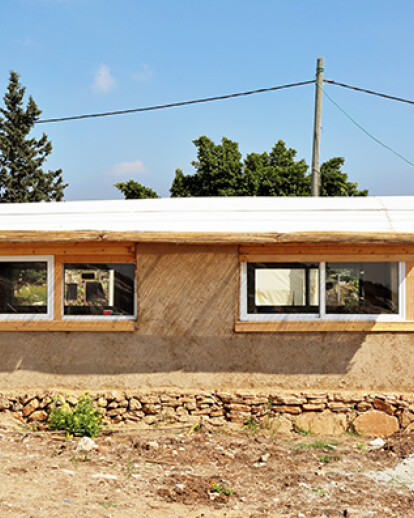Social and territorial context
The village of Ar Ramadin al Janub is situated in the seam zone of the Qalkilya Governorate and is collocated between the separation wall and Israel. The area is still West Bank, and the Bedouins of Ramadin are holding the Palestinian ID. The region is one of the greenest of Palestine, a region of hills where population is composed mostly by shepherd and farmers.
The village has around 80 students who attend school (primary and secondary) in Qalqilya and Habla. Children and youth use a bus provided by DCO (District Coordination Office) to go from Ar Ramadin al Janub, through Habla check point, to primary and secondary schools. The Habla check point is particularly tough, and is managed by private Israeli contractors, which worsen the controls on cars and people.
The children have to face some difficult situation such as long waiting and body search. In particular the girls are facing a difficult situation, connected with the local conservative culture, that does not intend to expose women, girls included, to embarrassing and uncomfortable situation that could prejudge their “reputation”. As a result, the level of drop out is high, and is affecting particularly the girls.
Due to the problems described, the community has set up a primary school, composed by 3 classes + 1 teachers room and toilettes services, with temporary structures (tents installed on concrete platform).
At the beginning of the works the community school was actually serving approximately 30 students residing in Ramadin al Janubi. The community of the near city of Al Farda, which is in the same situation, has decided to not send their children to the school considering the existing structure not adequate for the educational path.
This type of tents are temporary structures for situation of emergency, and are very cold in winter and hot in summer. They face moreover a fast deterioration. The goal of the project is to provide an adequate structure and to involve in the school also the Al Farda students.
The works have been conducted under the tents to avoid that the work site could be seen from the street and to avoid a demolition order by the Israeli’s Authorities. Thanks to their simple structure in metal tubes covered by a sheet the tents have been particularly suitable for this intent.
Architectural Project Because of the complexity of the political and economical situation, the design process has been carried on with a strict attention to the management of the available resources and in strong connection with the local community.
This choices brought to the decision to use the tents as a resource, in particular re-using the metal tubes structure as a grid around which build the new walls. The technique of Pisé that is used in the outside walls, has been re-interpreted and adapted to this main idea.
According to this approach the construction phases have been divided in simple steps: reinforce the metal tubular structure; provide a solid and waterproof basement; construct insulating walls and roof; building of partition with bricks that has been realized locally, provide finishing.
The re-use of the tubes is a way to recycle materials that otherwise would have ended their life cycle. The new interventions has been realized with natural and low-impact materials. Earth and straw compose walls and partitions and are used in two different techniques: Pisé (a mixture of straw and mud compressed in formworks) for the walls and the lightweight brick constructed in place for the partitions. The ceiling and pavement has been realized in wood, whether the plastering is made of clay and lime.
The aesthetic that comes from this process derives from the composition of the available materials, which are assembled to respond to specific problems; the building appearance is the form of the process that generated it. The arcs of the barrel vaults of the roof meet to create a landscape that goes along the topography of the place, and the shadows of the strong sunlight on the new volumes draw indoor and outdoor spaces and paths.
The works have been carried out in self-construction by the local community (including skilled people) with our supervision. This process is very important for us to provide not only a building, but a know-how endowment to the community, which is directly involved in all the process, from the design to the proper construction. As usual ARCò produced an instruction booklet illustrating the used techniques, so that the community will be able to maintain the building and even to build others with the same technique in the future.
The aim of this project was to create an opportunity of development in an emergency situation. The purpose is to define a method of intervention that can be used in different contexts in which a situation of emergency becomes permanent and so a daily, normal status for the inhabitants.
This way the developed system is replicable by the community, but even more: it is thought to be replicable in different places and moments. The tents we found in the school are, in-fact, a standard type, used all over the world by governmental and non-governmental organizations to provide shelters for communities affected by disasters or in state of emergency.
This kind of shelters are obviously supposed to be temporary but very often they finish to remain as a permanent solution in which people keep living for years.
The approach proposed by ARCò is able to transform emergency actions into development actions with a minimum amount of money. This approach would be more effective if scheduled since the beginning of a humanitarian action.





























